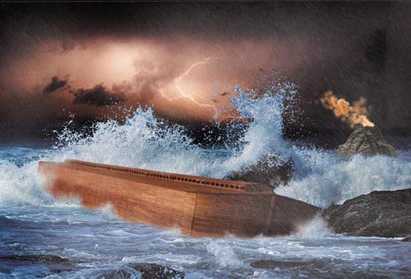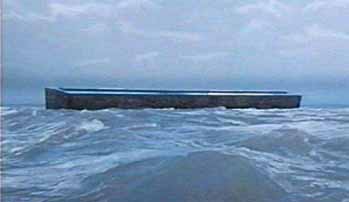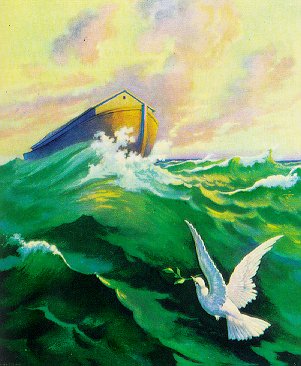
by John P. Pratt
28 Jan 2021, 1 Light (SR), 1 Creation (V), Deluge (UH)
©2021 by John P. Pratt. All rights Reserved.
|
1. The Flood as a Baptism 2. Curious Flood Dates 3. Baptism Like Birth 4. Conclusion Notes |
 |
In that research, it was explained that the reason for all of those details in the Deluge account in Genesis is that they were symbolic of the birth of the earth. For example, when the earth was created, it was all covered with water (Gen. 8:5,14). The day of the earth's birth was when the first mountain top was seen poking out of the ocean, when the earth came out from dark water into the light and into the air. Understanding this symbolism, the day of the rebirth of the earth would have been on the day when the mountain tops were first visible, which would explain why the date of that detail was included.
 |
Thus, while it has been taught openly that the Great Flood was the official baptism of the earth, my research has not discovered anywhere but in my own work where it has been suggested that the Deluge symbolized some of the actual steps of the creation and birth of the earth.
The purpose of this article is to point out that finally The Sealed Book, which now is considered to be scripture in the Reborn LDS Church,[5] confirms both that the Great Deluge was not only the baptism of the earth, but also represented it being created again. Let us consider that teaching:
Then, after the Flood and the destruction of all the ungodly people in the world of mankind, Noah and his descendants were to rebuild the new earth, which would be pure in the sight of God, for all the earth had passed away by a baptism, for the purpose of representing a new creation in the sight of the heavens.
— Sealed Book of Moses 6:7 in The Sealed Book (emphasis added).
Let us consider exactly what that might mean.
 |
So what was all of that about? Who cares if Noah let some birds out early or on what day the tops of the mountains were seen? If this is a campfire story, surely these details would not be important. If this is a revelation of God, then perhaps we should look at them more closely to see what they might mean.
First of all, there is a big clue that all of these dates are on the Hebrew Calendar because the entire period from when the rain first fell to when they exited the ark was one year and ten days. A typical Hebrew year is ten days short of a solar year, so that suggests that the Flood lasted exactly one year on a solar calendar, such as our Gregorian Calendar or the sacred Jubilee Calendar.
 |
The first column of Table 1 lists several key events of the Flood for which precise dates are given in Genesis. The second column lists the date on the Hebrew Calendar. The third column lists the date according to the modern Gregorian Calendar, the main calendar in worldwide use today. The first date in that column is in the year 2343 BC, and all the others are in 2342 BC. The next column lists the Julian Day (JD), which is simply a continuous count of days used by astronomers, which begins before recorded history, so that all historical dates are positive numbers. It is useful for calculating the number of days between any two dates by simply subtracting the earlier JD number from the later one. The numbers shown after the JD column show the number of days between the Julian Dates indicated by the square brackets. For example, there are exactly forty days between JD 866171 (Waters Abate) and 866211 (Raven Sent Out).
In the second column of the table, it turns out that nearly every event date listed is a holy day on the Hebrew Calendar. The day of the beginning of the Flood is not considered to be a holy day to Jews, but on the Jubilee Calendar,[7] that day was the holy day to begin watering, being ideal for the beginning of the Flood. Similarly, the last event listed, the day on which they exited the ark, was again that same holy day, exactly one Jubilee year later.
 |
Looking at the last column in Table 1, it is seen that in the account of the Flood the words "forty days" are not a vague unit of time, but do indeed mean exactly forty days. For example, it was said to rain for forty days. That means that the last day of rain was 39 days after the first. The Flood account goes on to say that it was 150 days after the rain stopped that the waters receded. In the table, it is seen that that day was indeed exactly 150 + 39 = 189 days after the first day of the Flood. The raven was sent out 40 days later. Then the 3 Decision Days each fell exactly one week after the raven left.
It is amazing that starting on 17 Heshvan, the day given when the rain began, then counting 40 days, then 150 days, then 40 more days, brings one precisely to the three sets of 7 days when Noah sent out birds, the dove being precisely on the three Decision Days on the Hebrew Calendar!
All of this detail was to show the reader that this account of the Deluge is not a campfire story of vague numbers, but a very precise account which leads to all of those key dates falling on holy days. As will now be discussed, the point of this article is that several parallel events in the Garden of Eden fell on these very holy days, showing that the Deluge was indeed symbolic of the birth of the earth.
Let us now consider several points which show that rebirth of the earth was very similar to its birth and to events in the Garden of Eden.
 |
Land Appears. There is a similarity of dates which provides supporting evidence that this connection of these two appearances of land was indeed intended. It has been suggested that the official birth date of the earth would have been when the land first appeared from the water, which would also be when the baptism of the earth was completed. The latter occurred on the first day of Summer, the holy day 1 Tammuz, as discussed above.
While we don't know exactly when the land appeared from the water during the creation, it has been possible to determine a date for the "Beginning of Mortality", being the date when Adam and Eve were driven out of the Garden of Eden (a paradise) into the world on Sun 9 Apr 4001 BC, being Passover on several sacred calendars (see my Religious Chronology for references.) That date occurred on Passover on several sacred calendars, which symbolism undoubtedly refers to Adam and Eve "passing over" from the garden into the mortal world.
What may be important for this article is that the Beginning of Mortality is somewhat similar to a birth date. For example, Adam's age is reckoned from that date when he became mortal. It turns out that on at least two sacred calendars, the "birth date" for the earth fell on the first day of summer, the same as when the mountaintop appeared after the Flood. That date was the major holy day 1 Summer (Uniform Enoch Calendar) and 1 Leo (also 1 Summer on the Uniform Star Calendar). Thus, there is a correspondence between those dates of "rebirth" from the Flood and of "birth" in the Garden of Eden both being on the first day of summer!
 |
That same quoted phrase is used to describe Satan wandering the earth: in the Book of Job, Satan said that he had been "going to and fro in the earth" (Job 1:7). Could the raven have been symbolic of Satan, when he was cast out of heaven, down to the earth (Rev 12:9), after which he entered the Garden of Eden to tempt Eve and Adam?
While that may be the case, let us look at the following Decision Days, on which the dove was sent out, for possible evidence supporting this conjecture.
 |
Eve Tempts Adam. After having eaten the forbidden fruit, Eve brings some to Adam. That day might correspond to Decision Day 2 during the Flood when the dove brought back leaf or branch of the olive tree to Noah. That is, Noah represented Adam as the new patriarch of the human family, and the female dove represented Eve. Thus, it has been suggested in my work that Eve waited an entire week before offering the fruit to Adam. That fits with it occurring on a Decision Day, because it was a big decision to offer it to him.
 |
Supporting evidence that such was the case is that the day was 1 Storm on the Sacred Round. Moreover, that day was holy on nine other sacred calendars, which is very rare. Some of those other holy days also fit the symbolism perfectly. For example, it was the major holy day of the End of the Grape Harvest on the Jubilee Calendar. There is a Hebrew tradition that the tree of knowledge of good and evil was a grape vine, which, if true, would be a bull's-eye. It was also 1 Adult on both the Venus and Uniform Venus calendars, the day in which one begins to rebel against God. Moreover, it was the day 1 Death on both the Mercury and Uniform Mercury Calendars. It was the major holy day Tabernacles on the Uniform Enoch Calendar and the day 1 Lord on the Mars Calendar. On the Star Calendar the day was the day of the star Spica, the Seed of Woman, representing Jesus Christ, the seed of the Virgin, who would atone for Adam's sin. On the Uniform Star Calendar the day was 1 Scorpion (considered to be a serpent in Biblical taxonomy), which was the Feast of Trumpets on that calendar. Thus, that day is not only holy on nine of sixteen known sacred calendars, the symbolism of nearly all of those holy days on different calendars fits the event exceedingly well!
Moreover, that day proposed for the Fall of Adam links to other "fall" dates in history. For example, the day 1 Storm was also the day of the Fall of Jerusalem on Thu 23 Jun 587 BC which date is given in the Bible to the very day as 9 Tammuz (Jer. 52:4). That also occurred on the day 1 Death on both the Venus and Mercury calendars.
There are so many witnesses that the proposed day for the Fall of Adam is correct, that it is not questioned at all in my work. In fact, we could have started on that day, which is a Decision Day 3 on the Hebrew Calendar, and worked backward to the temptation of Eve and her offering the fruit to Adam.
 |
Previous articles reporting my sacred calendar calendar work have noted that the Great Flood was the baptism of the earth and that precise dates could be proposed for many of the detailed events included in the Biblical account. Moreover, it has been proposed that the reason for including the exact dates of such seemingly insignificant events, such as when the mountaintops were first seen and even when some birds were released, was that those events were actually symbolic of events in the Garden of Eden. That is, that the rebirth of the earth at its baptism followed a similar pattern of events on holy days as occurred with Adam and Eve. If so, then those Flood dates could provide knowledge of the precise dates of some of those events of the creation.
When all of that was proposed between 2003 and 2006, there was no known scriptural evidence supporting that speculative connection of Flood events to Garden of Eden events. The purpose of this article is to point out that the The Sealed Book, recently translated from the sealed portion of the Plates of Mormon from which the Book of Mormon came forth, contains one verse in the description of the Great Flood which explicitly states that the earth's baptism represented a new creation. The word "represented" could mean that it not only was indeed a new creation, but also that it represented the same pattern which was used in the creation of the earth.
New tables were also presented which summarized both the precise dates of the Flood, but also the correlation of the events of both the baptism and birth of the earth. All of this precision in such minute details provides compelling evidence of the consistent attention to sacred dates which is contained in these timetables of the creations of God!